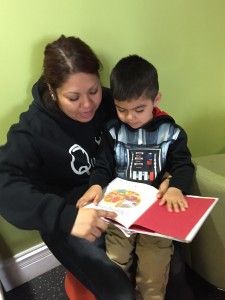Tips for reading to children—even if they can’t read yet
A child’s success as a reader begins much earlier than the first day of school. Although teaching someone to read seems like a daunting challenge (including what to read or how to read to your child) don’t let that stop you from making reading fun and fundamental! Below are some habits you or any family member can use to help your child on their lifelong journey of learning through reading.
Birth to Two Years
Babies are born ready to learn, and you provide many opportunities for your child’s learning! Infants and toddlers learn from everything around them. Responding when your baby makes sounds—crying, babbling, or cooing—provides the foundation for learning to talk, one of the most important skills for a child to develop during the early years. Your child listens and wants to imitate what she/he hears you say and sees you do. These early experiences will help your child become a successful reader later on.
Talk, Talk, Talk: talk about what you are doing and what your child is doing throughout the day; for example, describe your everyday activities, like changing your child’s diaper or feeding him or her. While your child may not be talking yet, treat this talk-time like a conversation.
Three to Five Years
 As children get a little older, their everyday experiences continue to help them learn. From taking a walk and describing things they see, to scribbling with crayons and scrap paper, children are building important skills, such as vocabulary and early writing. Preschool children enjoy playing with language—saying rhymes, singing songs, and talking about the books you read together.
As children get a little older, their everyday experiences continue to help them learn. From taking a walk and describing things they see, to scribbling with crayons and scrap paper, children are building important skills, such as vocabulary and early writing. Preschool children enjoy playing with language—saying rhymes, singing songs, and talking about the books you read together.
Word Play: read stories with rhymes and recite nursery rhymes with your child. Pause at the end of a sentence and let your child fill in the predictable word; this encourages your child to listen carefully.
Six to Eight Years
Starting elementary school is an exciting time for children. They look forward to learning to read and having a parent as their special partner in learning. Continue to talk, read, and write together. Encourage your child to talk about what he or she is learning. What subjects interest your child? Talk with your child’s teachers about ways to support learning at home.
Read, Listen, Read: First have your child read part of a story, and then you read the next part. Taking turns while you read is fun for both you and your child! It also allows your child to become a fluent reader. Fluency is defined as the ability to express oneself easily and articulately. The more you read together, the more practice your child will have with this skill.
Harvard Graduate School of Education has created a slideshow on what can parents and educators do to promote reading for fun throughout their academic development. Check it out:
Reading should be a special time you both look forward to. Always try to pick a comfortable spot to read and one with plenty of light. Also, make it a routine—whether it’s right before breakfast, or right before bed, set aside a special time every day. Lastly, give lots of encouragement while reading together!
